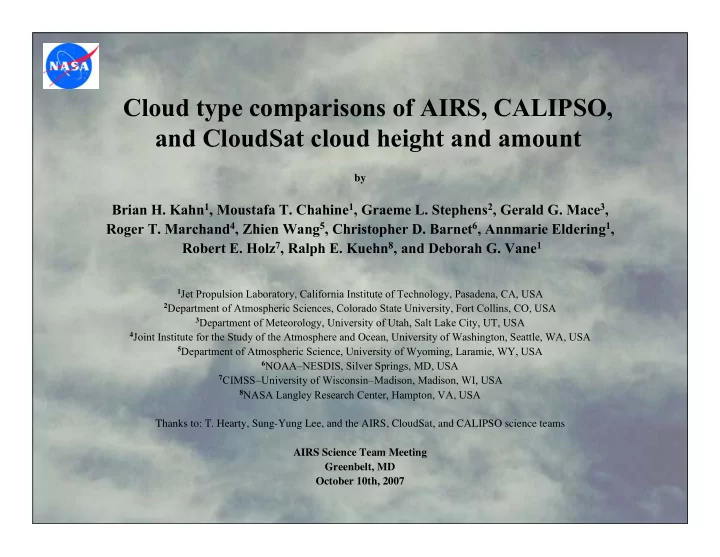

Cloud type comparisons of AIRS, CALIPSO, and CloudSat cloud height and amount by Brian H. Kahn 1 , Moustafa T. Chahine 1 , Graeme L. Stephens 2 , Gerald G. Mace 3 , Roger T. Marchand 4 , Zhien Wang 5 , Christopher D. Barnet 6 , Annmarie Eldering 1 , Robert E. Holz 7 , Ralph E. Kuehn 8 , and Deborah G. Vane 1 1 Jet Propulsion Laboratory, California Institute of Technology, Pasadena, CA, USA 2 Department of Atmospheric Sciences, Colorado State University, Fort Collins, CO, USA 3 Department of Meteorology, University of Utah, Salt Lake City, UT, USA 4 Joint Institute for the Study of the Atmosphere and Ocean, University of Washington, Seattle, WA, USA 5 Department of Atmospheric Science, University of Wyoming, Laramie, WY, USA 6 NOAA–NESDIS, Silver Springs, MD, USA 7 CIMSS–University of Wisconsin–Madison, Madison, WI, USA 8 NASA Langley Research Center, Hampton, VA, USA Thanks to: T. Hearty, Sung-Yung Lee, and the AIRS, CloudSat, and CALIPSO science teams AIRS Science Team Meeting Greenbelt, MD October 10th, 2007
Motivation – 1 • Results are submitted: • Kahn, B.H., M.T. Chahine, G.L. Stephens, G.G. Mace, R.T. Marchand, Z. Wang, C.D. Barnet, A. Eldering, R.E. Holz, R.E. Kuehn, and D.G. Vane (2007), Cloud type comparisons of AIRS, CALIPSO, and CloudSat cloud height and amount, Atmos. Chem. Phys. Discuss. , 7 , 13915– 13958. • Clouds and Earth’s climate • Radiative heating/forcing several times to orders of magnitude greater than climate change constituents (e.g., trace gases, aerosols) • (e.g., Hartmann et al. 1992; Forster et al. 2007) • Critical component of hydrological cycle (e.g., Webster 1994) • Very small amounts of water have very large climatic impacts • Cloud feedbacks at heart of climate forecast uncertainty (e.g., Stephens, 2005; IPCC) • Many other impacts
Motivation – 2 • Quantify precision of IR remote sensing of cloud properties • Characterize uncertainties, strengths, weaknesses • Ongoing re-assessments of algorithm changes • Collocated CloudSat and CALIPSO observations • Active measurements – precise cloud detection, vertical profiles • Cloud-type assessment • AIRS cloud height and amount used in retrieval of bulk, microphysical, optical, other cloud properties • Move towards combined retrievals using full power of A-train
Outline • An illustrative granule: the view from AIRS, CloudSat, and CALIPSO • FOV-scale comparisons: how to quantify? • A five-day climatology • CloudSat/AIRS comparisons by cloud type • Show joint PDFs • V4/V5 differences • Insights gained from comparisons • CALIPSO/AIRS comparisons • Differences and similarities compared to CloudSat • V4/V5 differences • Take home messages
An Illustrative Granule in Tropical Indian Ocean BT 960 BTD 1231–960 Up CTP Up ECF Low CTP Low ECF
An Illustrative Granule in Tropical Indian Ocean
Match CloudSat and CALIPSO to AIRS FOV AIRS/CloudSat (AIRS/CALIPSO) AIRS Cloud AIRS Cloud AIRS Cloud CC Homog Cloud CC Hetero Cloud CC Homog Clear AIRS Clear AIRS Clear AIRS Clear CC Homog Cloud CC Hetero Cloud CC Homog Clear
Five-day Zonally Averaged Cloud Frequency CloudSat All CloudSat Cloud Top Only CALIPSO All CALIPSO Cloud Top Only AIRS Upper + Lower ECF
Five-day Cloud Frequency ± 70º lat Percentages vary due to instrument sensitivity, resolution of FOV, algorithm differences, etc.
Significant Contribution from Size of FOV Lifted from Menzel et al., “ MODIS global cloud-top pressure and amount estimation: Algorithm description and results ”, J. Applied Met. Climatol . (in press)
Frequency PDFs of CloudSat – AIRS CTH Upper AIRS CTH – Top Bin CloudSat CTH Lower AIRS CTH – Top Bin CloudSat CTH
Cloud-type PDFs for Upper AIRS CTH Partition Upper AIRS CTH – Top Bin CloudSat CTH by Cloud Type
Cloud-type PDFs for Lower AIRS CTH Partition Lower AIRS CTH – Top Bin CloudSat CTH by Cloud Type
V4 vs. V5 Partitioned by Cloud-type V4 and V5 Differences
Certain cloud types much more spatially homogeneous Heterogeneous distributions of Clear, Ac, Cu, and Sc within AIRS FOVs Homogeneous distributions of As, Cb, Ci, and Ns within AIRS FOVs
V4 vs. V5: Significant Sample Size Changes V5–V4 Ascending 2004–01 V5–V4 Descending 2004–01 Plots courtesy of Sung-Yung Lee
Frequency PDFs of CALIPSO – AIRS CTH CALIPSO ≥ 7 km CALIPSO < 7 km AIRS Upper CTH AIRS Lower CTH
CALIPSO/AIRS V4 vs. V5 Differences CALIPSO ≥ 7 km CALIPSO < 7 km AIRS Upper CTH AIRS Lower CTH
“Take Home” Messages • CloudSat/CALIPSO and AIRS agreement dependent on cloud-type • AIRS missed/false detection rate lower with CALIPSO (good result) • Certain cloud-types more heterogeneous within AIRS FOV (Clear, Ac, Cu, Sc) • Differences between V4/V5 from certain cloud-types (Ac, As, Ci, Sc)
Recommend
More recommend